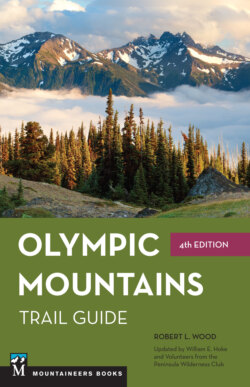Читать книгу Olympic Mountains Trail Guide - Robert Wood - Страница 22
На сайте Литреса книга снята с продажи.
ROADS AND CAMPGROUNDS
ОглавлениеDuring the early days of settlement in the Pacific Northwest, the Olympic Mountains had few visitors because they were virtually inaccessible due to lack of trails and roads. Today, however, one can reach the Olympics with comparative ease. Although still wild, the region is no longer unknown. The Olympic Highway, US 101, together with the highway connecting Grays Harbor with Puget Sound, encircles the Olympics. Numerous spur roads extend inward into the mountains from the encircling highways like the broken spokes of a wheel. Most of the roads follow river valleys and end at low elevations, but several climb the ridges to the high country. Although some of the roads are paved, most of these secondary routes are graveled two-lane tracks, at times so narrow as to require turnouts for vehicles to pass each other. Forest Service roads are identified throughout by the abbreviation FS.
Olympic National Park is essentially a wilderness crisscrossed by trails, with roads penetrating only short distances. Although the park is unmarred by a network of highways, the spur roads permit automobile travelers to see representative portions of its major features. The west-side roads provide access to the rain forests, where deer and elk are often observed. On the northern side the roads to Hurricane Ridge and Deer Park climb above 5000 feet, and travelers see a succession of snowfields and meadows, as well as the higher peaks.
At various times a proposal has been made to build a highway across the Olympics, but this would destroy the park’s wilderness character, which is its greatest asset. Moreover, the park’s unique features—the rain forests, the elk herds, the mountain-and-sea vistas—are already accessible to motorists.
The park exhibits, more by accident than design, a natural zoning. The primitive core, a true wilderness without trails, is surrounded by two concentric belts. The inner, broader belt contains the bulk of the trail system; the outer band is penetrated by both roads and trails.
Because the Olympic National Forest borders the national park on three sides, it forms, with state lands on the west, still another band in the concentric arrangement. Until recent years the national forest and state lands were, like the national park, almost roadless. Today, however, they are cut up by hundreds of miles of logging roads, and the road pattern is constantly changing. Consequently, such wilderness as remains in the national forest is primarily found in the high country that borders the national park on the east.
Both the National Park Service and the Forest Service maintain public campgrounds along the major roads. These have individual camping units with cooking facilities and picnic tables, but not all of them are equipped with piped water and comfort stations with flush toilets. The developed sites usually charge a fee for staying overnight.
Hikers who elect to begin or end their backpacking trips by staying in automobile campgrounds should not expect them to be as quiet and peaceful as they were decades ago. Today the campgrounds are inclined to be noisy, but perhaps this is merely a reflection of the present age. Usually, however, the campground stay is an enjoyable one, albeit not a wilderness experience— because dogs bark, children cry and shriek, radios blare, and motor vehicles break the stillness. The best locations are invariably selected by those who arrive early; thus riverside camps are usually occupied. Here, despite the noise and the cawing of crows before dawn, one can sleep well, lulled into dreamland by the mesmeric sound of the river.
